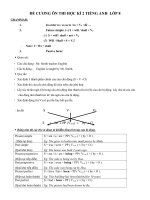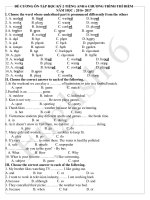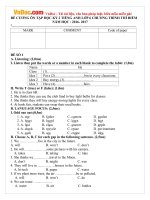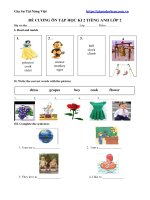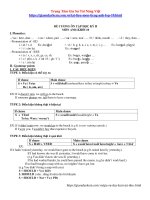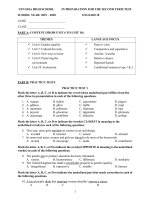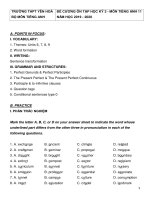ĐỀ CƯƠNG ÔN THI HỌC KÌ 2 TIẾNG ANH LỚP 8
Bạn đang xem bản rút gọn của tài liệu. Xem và tải ngay bản đầy đủ của tài liệu tại đây (195.78 KB, 10 trang )
ĐỀ CƯƠNG ƠN THI HỌC KÌ 2 TIẾNG ANH LỚP 8
GRAMMAR:
1.
In order to / so as to / to + V0 : để …
2.
Future simple: (+) S + will / shall + V0
(-) S + will / shall + not + V0
(?) Will / Shall + S + V0?
-
Note: I / We + shall
3.
Passive form:
• Quan sát:
- Câu chủ động : Mr. Smith teaches English.
- Câu bị động : English is taught by Mr. Smith.
• Quy tắc:
- Xác định 3 thành phần chính của câu chủ động (S + V +O)
- Xác định thì của câu chủ động để chia tobe cho phù hợp.
- Lấy túc từ/tân ngữ (O) trong câu chủ động làm thành chủ từ (S) của câu bị động. Lấy chủ từ của câu
chủ động làm thành túc từ/ tân ngữ của câu bị động.
- Xác định động từ (V) có qui tắc hay bất qui tắc.
- Sơ đồ
S
S
V
+ be + PP (V3/ed) +
O
by + O
ã Bảng tóm tắt các thì và động từ khim khuyết trong câu bị động.
Present simple
S + am / is / are + PP ( V3/ed ) + ( by + O ).
(Hiện tại đơn)
Past simple
Eg: The glass is broken into small pieces by Minh.
S + was / were + PP ( V3/ed ) + ( by + O ).
(Quá khứ đơn)
Present progressive
Eg: The house was built 2 years ago.
S + am / is / are + being + PP ( V3/ed ) + ( by + O ).
(Hiện tại tiếp diễn)
Past progressive
Eg: The cake is being cut by Hoa.
S + was / were + being + PP ( V3/ed ) + ( by + O ).
(Quá khứ tiếp diễn)
Present perfect
Eg: The cake was being cut by Hoa.
S + have / has + been + PP ( V3/ed ) + ( by + O ).
(Hiện tại hoàn thành)
Past perfect
Eg: This building has been finished for 10 years.
S + had + been + PP ( V3/ed ) + ( by + O ).
(Quá khứ hoàn thành)
Eg: The picture had been drawn by Ba.
Future simple
S + will + be + PP ( V3/ed ) + ( by + O ).
(Tương lai đơn)
Be going to
Eg: A new house will be built near here next year.
S + am/is/are + going to + be + PP ( V3/ed ) + ( by + O ).
(Tương lai gần)
Eg: The cake is going to be made by Lan.
MODEL VERBS
S+
(Động
từ
khiếm
can/could/would/should
+ be + PP ( V3/ed ) + (by + O ).
must/have to/may/might
khuyết)
4. Adjectives:
a. S + be + adj + to + V0
Eg: It’s easy to understand this lesson.
b. S + be + adj + that + S + V….
Eg: I am delighted that you passed your exam.
5. –ed and – ing participles.
V-ed : là phân từ quá khứ - thường dùng cho sự vật, sự việc.
V-ing : Phân từ hiện tại – thường dùng cho người.
Eg: - The old lamp made in China is 5 dollars.
- The boy reading a book is Ba.
6. – Do you mind / Would you mind + V-ing….?
- Do you mind if I + V1 ………?
- Would you mind if + V2/ed ………..?
Eg: Would you mind if I took a photo?
Would you mind taking a photo?
Do you mind if I take a photo?
Do you mind taking a photo?
7. Past progressive ( Quá khứ tiếp diễn).
* Use: - Diễn tả 1 sự việc đang diễn ra tại 1 thời điểm cụ thể trong quá khứ.
(+) S + was / were + V-ing + ……….
(-) S + was / were + not + V-ing +…………
(?) Was / Were + S + V-ing +…….?
* Past progressive with “when” and “while”
Form: Quá khứ tiếp diễn – when - Quá khứ đơn
Quá khứ đơn – while – Quá khứ tiếp diễn
Eg: While Hoa was eating, the phone rang.
When Lan arrived at school, the school drum was sounding.
-
Note: Khi 2 hành động diễn ra cùng 1 lúc (song song) ở 1 thời điểm trong quá khứ thì:
Quá khứ tiếp diễn – while – Quá khứ tiếp diễn
8. Progressive tense with always. ( Hiện tại tiếp diễn với always).
S + am/ is/ are + always + V-ing.
Eg: Mrs Nga is always losing her umbrella.
9. Compound words: a/an + N – V-ing + N
Eg: a rice- cooking contest, a water-fetching contest, a fire – making contest,…….
10. Reported speech ( câu tường thuật / gián tiếp)
* Dạng trần thuật:
a. S1 + said that + S2 + Vlùi thì
b. S1 + told + O + that + S2 + Vlùi thì
Eg: 1. “ I can fix the faucets” he said.
He said that he could fix the faucets.
2. My friend said to me: “I can repair the bike myself”
My friend told me that he could repair the bike himself.
*Dạng Yes/No question:
S + asked + O + if/ whether + S + Vlùi thì
Eg: “ Is it far from Ha Noi?”Nga asked Nhi.
Nga asked Nhi if it was far from Hanoi.
“ Do you know My Son , Nga?”Nhi asked.
Nhi asked Nga if she knew My Son.
•
Cách lùi thì, đổi trạng từ chỉ thời gian, nơi chốn:
Câu trực tiếp
- Hiện tại đơn
Câu gián tiếp
- Quá khứ đơn
- Hiện tại tiếp diễn
- Quá khứ tiếp diễn
- Hiện tại hoàn thành
- Quá khứ hoàn thành
- Quá khứ đơn
- Quá khứ hoàn thành
- Can
- Could
- Will
- Would
- Is
- Was
- Are
- Were
- Must
- Had to
- Shall
- Should
- May
- Might
•
- This
- That
- Now
- Then
- Here
- There
- Today
- That day
- Yesterday
- The day before
- Tomorrow
- The following day
- Next week / year
- Last week / year
- The following week / year
- The previous week / year
Cách đổi đại từ nhân xưng:
+ Ngôi thứ nhất: “I, we, me, us, my, our” đổi phù hợp với chủ từ của mệnh đề tường thuật.
+ Ngôi thứ 2: “you, your” đổi phù hợp với túc từ/ tân ngữ của mệnh đề tường thuật.
+ Ngôi thứ 3: “he, she, it, they, him, her, his, them, their” thì giữ nguyên.
11. Question words before to-infinitives.
S + V2/ed + O + Question words + to + V0
( Question words: how / what / where / which / who / why / when / ………)
Eg: Nga told Nhi how to go there.
12. Verb + to-infinitive: V + to + V0
Eg: Nhi decided to go for a run.
13. Modal verbs (Động từ khiếm khuyết)
S + can/ could/ may/ might/ will/ would/ shall/ should + V0
Eg: She might go along the beach for 20 minutes.
14. Requests / Offers / Promises (bảng SGK trang 81)
15. Prepositions (Giới từ)
- thank + for + V-ing
- be fond + of
- keen + on
- be afraid + of
- interesting / interested + in
- take part + in
16. Pronunciation: -ed
+ /id/ : t, te, d, de
+ /t/ : s, ss, (se), ph, ch, (gh), sh, x, p, pe, k, ke
+ /d/ : còn lại
PRACTICE:
I. Circle the letter A, B, C, or D to indicate the correct answer to each of the following questions.
1. Thanks ………………. me the money. I’ll pay you back on Friday.
A. for lending
B. lending
C. to lend
D. about lending
C. broken
D. reused
2. Milk bottles can be ………..after being cleaned.
A. collect
B. thrown away
3. An ………………….. contest will be held at my school next week.
A. English – speak
B. English – spoken
C. English – speaking
4. “Mrs. Lan: “Could you give me a cup of water?”
“Hoa: ………………….....................”
A. Yes, please
B. Sure. Here you are
C. I hope so
D. English – spoke
D. I’m glad. Thanks
5. They are going to buy a map……………………get lost.
A. not so as to
B. to not to
C. so not as to
D. so as not to
C. forgetting
D. forgets
6. He is always …………….to do his homework.
A. forget
B. forgot
7. “Do you want to visit Dien Bien Phu, Linda?” – Nam asked Linda _______
A. if he wanted
B. if she wanted
C. if she wants
8. She said she ................................ a worker in a large factory.
A. is
B. has been
C. was
9. I don’t know where ……………......souvenirs.
A. buying
B. bought
C. buy
10. Lien decided ..........................to Ho Chi Minh City yesterday
A. going
B. went
C. go
11. We ................................. TV at 8 o’clock last night.
A. were watching
B. are watching
C. watched
12. When there was a knock on the door, I …………………..dinner.
A. was eating
B. is eating
C. eat
13.At 9 o’clock yesterday, we ………………… on the beach.
A. are lying
B. have lain
C. lay
14.Tom burnt his hand while he ………………… the dinner.
A. was cooking
B. has cooked
C. cooked
15.My friend asked me ………………… I studied at a school in the city center.
A. when
B. whether
C. then
16.. ......................... is a chair with wheels for somebody who cannot walk.
A. Stretcher
B. Ambulance
C. Wheelchair
17. It’s a car- ……………… industry.
A. makes
B. making
C. make
18. He is always…………………in the classroom.
A. talk
B. talked
C. talks
to visit Dien Bien Phu.
D. if he wants
D. will be
D. to buy
D. to go
D. watch
D. ate
D. were lying
D. cooks
D. unless
D. Crutch
D. made
D. talking
19. Would you mind If I…………………a photo?
A. take
B. took
C. will take
D. have taken
20. The boy …………………….. next to Hoa is a new comer.
A. sits
B. to sit
C. sitting
D. sit
21. Presents ………………….. in colored paper and put under the Christmas tree.
A. are wrapped
B. are wrap
C. are wraped
D. are wrapping
22. We …………………the film since we were young.
A. has seen
B. was seen
C. were seen
D. have seen
23. The Pyramid of Cheops is one of the seven …………………….of the world.
A. wonders
B. landmarks
C. temples
D. pyramids
24. Anita is fond …………playing the piano.
A. in
B. on
C. of
D. for
25. Nga showed Nhi where ………………………………… tickets.
A. get
B. to get
C. getting
D. got
26. It's too cold outside. Would you mind …………………………… the window?
A. close
B. closed
C. closing
D. to close
27.We have lived in Nam Dinh ………………….. over 20 years.
A. in
B. for
C. from
D. since
28.Would you mind if I ………………….. on the radio?
A. turn
B. turning
C. turned
D. will turn
29.The poem ………………….. by Clement Clarke Moore became popular in the USA.
30. Sally is quite keen ………………….. the idea.
A. in
B. for
C. of
D. on
31 ………………….. is a religious song that people sing at Christmas.
A. Carol
B. Poem
C. Christmas card
D. Patron saint
32. Jack ………………….. his homework between 8 pm and 9 pm.
A. did
B. was doing
C. made
D. was making
33. Do you mind ………………….. I leave early?
A. if
B. when
C. that
D. θ
34………………….. is used to check one’s eyesight.
A. Eye-shade
B. Eyeglass
C. Eye piece
D. Eye chart
35. The new hotel ………………………….. next year.
A. is opened
B. will be opened
C. is opening
D. opens
36. I ................... swimming very much.
A. wait
B. try
C. enjoy
D. finish
37. She said she .................... a worker in a large factory.
A. is
B. has been
C. was
D. will be
38. She told me how ………………....English words well .
A. learn
B. to learn
C. learned
D. learning
39. The teacher told him………………….. up late.
A. to not stay
B. to stay not
C. to stay not
D. not to stay
40.It’s Lan’s daily mistake. She is always ……….. to school late.
A. come
B. coming
C. comes
D. came
II. Choose the word whose underlined part is pronounced differently from that of the rest in each of
the following questions.
1. A. prison
B. limestone
C. kind
D. tribe
2. A. which
B. who
C. when
D. where
3. A. hard
B. carry
C. card
4. A. attracted
B. answered
C. appeared
5. A. upset
B. museum
C. custom
III.Choose the word whose main stress is placed differently from the others.
1. A Christmas
B. jolly
C. compete
2. A. unsuitable
B. traditional
C. participate
3. A. typhoon
B. victim
C. treatment
D. yard
D. designed
D. unsuitable
D. teammate
D. competition
D. fainting
4. A. museum
B. gallery
C. business
D. liberty
5. A. surprise
B. include
C. complain
D. bother
IV. Circle the letter A, B, C, or D to indicate the word or phrase that needs correcting.
1. Would you mind if I decorate the Christmas tree?
A
B
C
D
2. The woman carried a bag is Miss Lien.
A
B
C
D
3. Greg is always forget his keys and that really annoys me.
A
B
C
D
4. The Statue of Liberty is presented to the USA by France in 1897.
A
B
C
D
5. She showed me where did I left my luggage.
A
B
C
D
V. READING:
A.
The Statue of Liberty, one of America’s most familiar image, is on an island in New York Harbor. It is
a symbol of freedom. It was a gift to American people from French to show the friendship between the two
nations. This is the statue of a woman who is wearing a loose robe and a crown on her head. Her right hand
holds a burning torch, and her left hand holds a tablet with the date July 4, 1776 on it. The statue weighs 205
tons and is 46 meters high. It stands on a stone base. The base and pedestal increase the height of the
monument to 93 meters. The statue was completed in 1884 in France, and then transported to America in
1886. Tourists can visit the statue from 9.30 am to 5.00 pm daily except Christmas Day.
1.Write True (T) or False (F)
1-The Statue of Liberty is the most familiar image in America. ……………….
2-The statue was a present from American people to French people. …………...
3-The statue was completed in 1884 in America. ………….
4-Tourists cannot visit the statue on Christmas Day. …………..
2. Answer
5. Where is The Statue of Liberty?
_____________________________________________________________________________________
6. How much does the Statue weigh?
_____________________________________________________________________________________
7. What time can tourists visit the Statue?
_____________________________________________________________________________________
B.
In the country of China, there is a wall that is over 1,500 miles long. It is called the Great Wall of
China. It winds uphill and down, through valleys and mountains. Every inch of this 1,500 - mile wall was
made by hand.
The Great Wall of China was made many, many years ago. The people of China made it to keep out
their enemies. There are watch towers all along the way. The wall was made of brick and earth. It is high and
wide on top. People can walk along the top as if it were a road.
It is said that it took ten years to build one part of this wall. No other defense line has ever been made
as long as the Great Wall of China.
(enemies: kẻ thù
watch towers: tháp canh)
1.Write True (T) or False (F)
1- The Great Wall was made with the help of machines. ……
2- The wall was made of brick and earth. ……
3- The people of China made it to keep out their enemies. …..
4- It took ten years to build the Great Wall. ….
2. Answer
5. How long is the Great Wall?
_____________________________________________________________________________________
6. How long ago was the Great Wall built?
_____________________________________________________________________________________
7. Can people walk along the top?
_____________________________________________________________________________________
C.
Paper and paper products can be easily recycled. Cardboard, newspaper, and high-quality papers can all be
recycled. Different kinds of paper - like newsprint and high-quality white paper - are sorted into separate
piles because they are processed differently.
Paper is recycled by shredding it into small pieces and mixing it with water. The mixture is beaten into
mush, called pulp, that flows onto a moving screen where most of the water is taken out. Wood or paper
fibers remain and the fiber is pressed through rollers that squeeze out more water. It is then dried in a steam heated dryer. The result is recycled.
•
True/ False statements.
Statements
True
False
(T)
(F)
1.Recycling on paper and paper products is difficult.
2. We cannot recycle news print and high-quality white paper.
3. People use water when they recycle paper.
VI. Fill each blank in the following story with the correct word from the box.
A.
was
Golden
place
game
America
clue
Hoa, Nga and her cousin Nhi were bored, so Nga suggested that they play a (1)……………..called
20 Questions. She explained the rules and then the girls started to play. Nga thought of a (2)…………….and
she gave the others a (3)…………..by saying that it wasn’t in Viet Nam. Nhi found out the place was in (4)
…………….Hoa thought it was the (5)…………Gate Bridge, but that is in San Francisco. Nhi was right
when she said it (6)…………….the Statue of Liberty.
1/__________________________ 2/ ___________________________ 3/ ___________________________
4/__________________________ 5/ ___________________________ 6/ ___________________________
B.
festival
separate
run
competitions
traditional
rice – cooking
The rice-cooking (1)……….was held in the communal house yard about one kilometer away from a
river. There were three ( 2) ………: water - fetching, fire-making and (3)………. The festival took one day.
In the water-fetching contest one person from each team had to (4) ………… to the river to get the water.
In the fire-making contest two team members had to make a fire in the (5)…………….way. They tried to
rub pieces of bamboo together to make the fire.
Six people from each team took part in the rice-cooking contest. They had to (6) ………………. the rice
from the husk and then cook the rice.
1/__________________________ 2/ ___________________________ 3/ ___________________________
4/__________________________ 5/ ___________________________ 6/ ___________________________
VII. Rewrite the following sentences without changing the meaning.
1. It is a contest in which they climb the mountain.
(Use a compound word)
It is__________________________________________________________________________________
2. I bought a machine which makes coffee.
(Use a compound word)
I bought______________________________________________________________________________
3. It is a contest in which participants have to fetch water.
(Use a compound word)
It is a______________________________________________________________________________
4. “I can play the guitar and the piano.” Nam said.
(Reported speech)
Nam said_____________________________________________________________________________
5. “I am going to see a movie this evening” Hoa said.
(Reported speech)
Hoa said_____________________________________________________________________________
6. Do many people live at My Son?
(Reported speech)
The tourist asked Tam___________________________________________________________________
7. He said to me “ Is the Golden Gate Bridge in San Francisco?”
(Reported speech)
He asked me __________________________________________________________________________
8. John will deliver the letter.
(Change into passive voice)
The letter_____________________________________________________________________________
9. Mr. Smith will read this report at the conference.
(Change into passive voice)
This report____________________________________________________________________________
10.She bought a lot of flowers for her mother.
(Change into passive voice)
A lot of flowers________________________________________________________________________
11. Could you explain the lesson to me?
(Make a request)
Do you mind__________________________________________________________________________
12. May I ask you some questions?
(Make a request)
Would you mind if I____________________________________________________________________
13.Can you correct this composition for me ?
(Make a request)
Would you mind _______________________________________________________________________
14.Could you explain the lesson to me?
Do you mind if I ______________________________________________________________________
